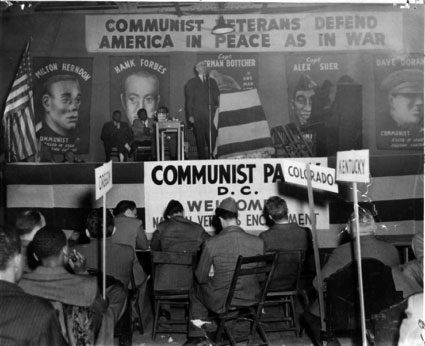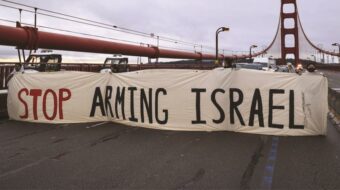
As the Communist Party USA’s second decade ended, World War II, the greatest war in human history, began. In all major capitalist countries, the mass media blamed the war on the Soviet Union’s signing of a non–aggression pact with Nazi Germany and condemned Communist Parties’ support for the Soviet Union. Was there truth to the allegation that Communists—both in the Soviet Union and around the world—had helped Hitler start the war?
The first question to ask should be: What were Communists in the U.S. and throughout the world supporting and working for in the 1930s?
As Hitler’s fascist regime in Germany established a dictatorship based on extreme forms of racism and militarism, used terror and murder against its political enemies and the Jewish religious minority, engaged in an enormous military buildup, and threatened wars of conquest against its neighbors, the major European capitalist countries did nothing.
The Soviet Union, however, did do something. It called on the League of Nations to follow a policy of collective security, meaning the development of international commitments to stop Hitler and his ally Mussolini’s aggressions in Europe and Africa, as well as the Japanese Empire’s expansionism in Asia.

Communists in the U.S, like Communists in all countries not under some form of right-wing dictatorship, organized demonstrations and campaigns against Mussolini’s colonial invasion of Ethiopia (1935), Japan’s launching of a full-scale war against China (1937), and Nazi Germany’s savage and escalating persecution of Germany’s Jewish minority. Communists called for consumer boycotts of goods imported from the fascist states and led campaigns against U.S. corporations (Standard Oil, GM, Ford) who made huge profits by helping to build up the war machines of the fascist powers. While companies like Standard Oil, GM, and Ford were doing business with Hitler,” at home they fought ferociously to prevent their workers from organizing unions.
When Hitler and Mussolini backed General Francisco Franco’s Fascist coup against the elected government of the Spanish Republic with tanks, bombers, and thousands of troops in 1936, the Soviet Union was the only major power that provided military aid to the Republic as it fought against great odds to survive. Communists throughout the world played the leading role in mobilizing anti-fascist volunteer brigades to fight alongside the defenders of the Spanish democracy. CPUSA members were the organizers of the Abraham Lincoln Brigade—the name taken by the over 3,000 U.S. volunteers who fought against fascism in Spain.
But the policy of collective security advanced by the Soviet Union and the world Communist movement failed because the major European powers, led by the British Empire and British Prime Minister Neville Chamberlain, advanced a policy of “appeasement,” giving the fascist states what they wanted in order to avoid war and/or insure that any possible war would be directed against the Soviet Union. At the Munich Conference of 1938, Chamberlain and Eduard Daladier, the British and French leaders, met with Hitler and Mussolini to dismember Czechoslovakia and give it over to Nazi Germany. The elected government of Czechoslovakia was not even allowed to attend the conference which destroyed it as a nation. Japan, meanwhile, continued its undeclared war of conquest in China, killing millions, with no embargo or sanctions from any of the major capitalist countries.
2019 marks a century since the founding of the Communist Party USA. To commemorate the anniversary of the oldest socialist organization in the United States, People’s World has launched the article series: 100 Years of the Communist Party USA. Read the other articles published in the series and check out the guidelines about how to submit your own contribution.
Playing for time to build up both their military forces and their strategic position for a war they knew was inevitable, the Soviets negotiated a non-aggression pact with Nazi Germany which the capitalist media, most of whom had supported the Munich agreement, called “the Hitler-Stalin Pact.”
Communist Parties around the world defined the war, in those early days, as a conflict between rival imperialist blocs but continued and intensified their fight against militarism and racism. Nazi Germany conquered Western Europe in the spring of 1940, not because of their non-aggression pact with the USSR, but because the Allied powers expected Hitler to go to war against the Soviet Union and were not prepared to fight.
Those in Europe who earlier supported the appeasement of Hitler at Munich now capitulated to him and either established fascist collaborator governments or accepted the occupation of their countries.
Communists at the same time used their organizational skills and experience, courage, and commitment to play a leading role in developing anti-fascist resistance movements which would grow into Partisan fighting organizations in European and Asia-Pacific nations.
In the U.S., the CPUSA, targeted because of its anti-war stance by its enemies, continued to mobilize workers in trade union struggles and intensified its anti-racist campaigns even though the heightened oppression it faced and negative responses to its continued solidarity with the Soviet Union and the world Communist movement after the non-aggression pact cost it thousands of members.
Making the World Safe for Democracy, Socialism, and Peace: The CPUSA and WWII
Launching in June 1941 the greatest military invasion in history against the Soviet Union with over three million troops, Nazi Germany and its fascist allies changed the character of the war and its eventual outcome. Communists understood this change and intensified their resistance activities in fascist and occupied countries and their work to build “win the war” coalitions in allied and neutral countries.
So did “America First” leaders like Charles Lindbergh who virulently opposed U.S. aid to the Soviet Union under the lend-lease program even more than he had earlier opposed aid to Great Britain. The America First slogan and movement, revived by Trump in 2016, was the rallying call of those who wished to either collaborate with the fascist Axis powers and/or emulate their policies in the U.S.
Even before the U.S entered the war following the Pearl Harbor attack, Communist activists sought to mobilize the trade unions and all mass organizations to fight against the America Firsters. Communists also took up President Franklin Roosevelt’s call to make the U.S. “the arsenal of democracy” and win the “battle of production,” which, given U.S industrial capacity (about 1/3 of the world’s total in 1939), was essential to victory.
Along with the sacrifice and heroism of the thousands of CPUSA members who served in the armed forces, many in combat situations, these actions represented the highest form of both patriotism and internationalism.
But the war at home between capital and labor, the war against racism and anti-Semitism, continued after Pearl Harbor. U.S. corporations—for whom profit for their owners, investors, and executives was and is their price for patriotism—dragged their feet on war production, worried that Hitler would win the war and they would lose their European markets while their German and European subsidiaries continued to produce war material for the Axis. Only guaranteed high-profit contracts and increased government regulation led them to greatly expand war production.
Communists also fought to advance the Fair Employment Practices Commission (FEPC) which the New Deal government had created in 1941 to integrate Black workers into the expanding war production industries, which business initially sought to ignore.
These struggles took many forms at the grassroots level. Communist trade unionists in defense plants worked to defend Black workers from racist foremen and to challenge racist attitudes among white workers. Communists also fought to integrate union leadership, which led their opponents in union leadership to accuse them of seeking “special privileges” for Black workers. Racism was used against them in leadership struggles and also in wildcat strikes that anti-Communist factions launched against the integration of Black workers in war production jobs.

Just as Abraham Lincoln’s re-election victory in 1864 was necessary to both the abolition of slavery and victory in the Civil War, Roosevelt’s re-election in 1944 was necessary to both saving and advancing the labor and social welfare gains of the New Deal government and winning both the war and the peace.
CPUSA activists supported the CIO’s creation of a national political action committee (CIO-PAC) which played a major role in mobilizing workers to defeat conservative coalition candidates. CIO-PAC was able to organize Texas workers to force Martin Dies, founder and Chairman of HUAC, out of Congress.
Communists helped to bring Roosevelt’s campaign for a second Economic Bill of Rights, the first and so far the only time that a U.S. administration advanced a program that had major socialist components, to millions of working people. These rights included employment, education, housing, and health care for all.
While this people’s movement failed narrowly to stop machine politics and Southern segregationist Democrats from removing Vice President Henry Wallace from the Roosevelt ticket in 1944 and replacing him with Sen. Harry Truman, a centrist politician and product of the Kansas City Democratic machine, it played an important role in re-electing Roosevelt.
But the hopes for a postwar America and world embodied in both President Roosevelt’s Economic Bill of Rights and the planning for a United Nations organization would soon be threatened by the war which followed the end of WWII—the Cold War.












Comments